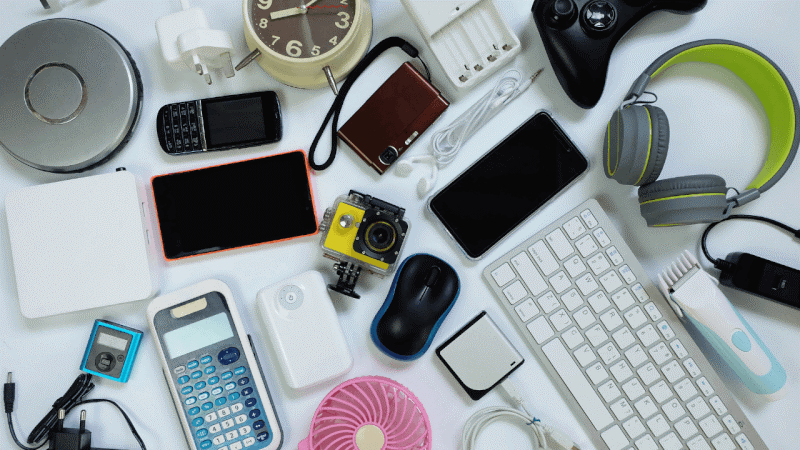Trends in Digital Health Gadgets
As we venture deeper into 2024, technology continues to advance at a rapid pace, delivering innovative gadgets that promise to enhance our lives in various ways. From state-of-the-art smartphones to groundbreaking smart home devices, this year’s tech offerings are more impressive than ever. In this article, we’ll explore the best tech gadgets of 2024, highlighting their features, benefits, and how they stand out in a crowded market.

- Smartphones: The Pinnacle of Mobile Innovation
In 2024, smartphones have reached new heights of sophistication, blending powerful performance with sleek designs and advanced features.
1.1 Apple iPhone 16 Pro Max
Features:
- Display: 6.9-inch Super Retina XDR display with ProMotion technology.
- Processor: A18 Bionic chip.
- Camera System: Triple-lens system with improved Night Mode and 8K video recording.
- Battery Life: Up to 24 hours of video playback.
- Software: iOS 18 with enhanced privacy features.
Pros:
- Exceptional display quality.
- Fast and efficient performance.
- Advanced camera capabilities.
Cons:
- Expensive compared to competitors.
- Limited customization options.
1.2 Samsung Galaxy S24 Ultra
Features:
- Display: 6.8-inch Dynamic AMOLED 2X with 120Hz refresh rate.
- Processor: Snapdragon 9 Gen 3.
- Camera System: Quad-lens system with 200MP primary sensor and 10x optical zoom.
- Battery Life: 30 hours of talk time.
- Software: One UI 6 based on Android 14.
Pros:
- Superior camera quality.
- Robust performance with high refresh rate display.
- Extensive customization options.
Cons:
- High price point.
- Bulkier design.
- Laptops: Power Meets Portability
Laptops in 2024 are all about balancing power with portability, offering impressive performance for both work and play.
2.1 Apple MacBook Pro 16 (2024)
Features:
- Display: 16.2-inch Liquid Retina XDR display.
- Processor: M3 Max chip with 12-core CPU and 38-core GPU.
- Memory: Up to 64GB unified memory.
- Battery Life: Up to 22 hours of web browsing.
- Software: macOS 14 with Stage Manager enhancements.
Pros:
- Outstanding performance and battery life.
- Stunning display quality.
- Excellent build quality.
Cons:
- High price.
- Limited ports.
2.2 Dell XPS 15 (2024)
Features:
- Display: 15.6-inch OLED InfinityEdge display.
- Processor: Intel Core i9-13900HK.
- Memory: Up to 32GB DDR5 RAM.
- Battery Life: Up to 18 hours of mixed usage.
- Software: Windows 11 Pro.
Pros:
- High-quality display and build.
- Powerful performance.
- Versatile connectivity options.
Cons:
- Price can be steep for higher configurations.
- Battery life varies with usage.
- Wearables: Enhancing Health and Connectivity
Wearables in 2024 offer more than just fitness tracking; they integrate seamlessly with our digital lives to provide valuable insights and connectivity.
3.1 Apple Watch Series 9
Features:
- Display: 45mm Always-On Retina display.
- Processor: S9 chip.
- Health Features: Advanced ECG, blood oxygen monitoring, and new mental health tracking.
- Battery Life: Up to 18 hours.
- Software: watchOS 10.
Pros:
- Comprehensive health and fitness tracking.
- Smooth integration with iOS.
- Durable and stylish design.
Cons:
- Battery life could be better.
- Premium pricing.
3.2 Fitbit Charge 6
Features:
- Display: 1.7-inch AMOLED display.
- Processor: Custom Fitbit processor.
- Health Features: Enhanced sleep tracking, stress management, and heart rate monitoring.
- Battery Life: Up to 7 days.
- Software: Fitbit OS 5.
Pros:
- Long battery life.
- Affordable pricing.
- Good range of health and fitness features.
Cons:
- Less advanced compared to high-end smartwatches.
- Limited app ecosystem.
- Smart Home Devices: The Future of Living
Smart home technology continues to evolve, offering greater convenience and integration for a connected lifestyle.
4.1 Google Nest Hub Max (2nd Gen)
Features:
- Display: 10-inch HD touchscreen.
- Processor: Google Tensor G2 chip.
- Smart Features: Built-in Google Assistant, video calling, and smart home control.
- Audio: Improved speaker system with enhanced bass.
- Software: Google Home app integration.
Pros:
- Great display and sound quality.
- Seamless integration with Google ecosystem.
- Versatile smart home control.
Cons:
- Privacy concerns with always-on microphone.
- Limited third-party app support.
4.2 Amazon Echo Studio (2024)
Features:
- Audio: High-fidelity sound with 3D audio capabilities.
- Voice Assistant: Amazon Alexa.
- Smart Features: Multi-room audio, home automation controls.
- Connectivity: Supports Zigbee and Thread.
Pros:
- Excellent sound quality.
- Robust smart home integration.
- Strong Alexa capabilities.
Cons:
- Bulky design.
- Alexa’s ecosystem may not appeal to all users.
- Analysis Table
| Gadget | Key Features | Pros | Cons |
| iPhone 16 Pro Max | 6.9-inch display, A18 chip, 8K video, iOS 18 | Excellent display, powerful performance | Expensive, limited customizability |
| Galaxy S24 Ultra | 6.8-inch AMOLED, Snapdragon 9 Gen 3, 200MP camera | Superior camera, high refresh rate display | High price, bulkier design |
| MacBook Pro 16 | 16.2-inch display, M3 Max chip, up to 64GB RAM | Outstanding performance, excellent display | High price, limited ports |
| Dell XPS 15 | 15.6-inch OLED, Intel Core i9, up to 32GB RAM | Powerful performance, high-quality build | High price, battery life varies |
| Apple Watch Series 9 | 45mm display, S9 chip, advanced health tracking | Comprehensive health features, stylish | Short battery life, premium pricing |
| Fitbit Charge 6 | 1.7-inch AMOLED, custom processor, 7-day battery | Long battery life, affordable | Less advanced, limited apps |
| Nest Hub Max (2nd Gen) | 10-inch touchscreen, Google Assistant, video calling | Great display and sound, good smart home control | Privacy concerns, limited apps |
| Echo Studio (2024) | High-fidelity sound, Alexa, multi-room audio | Excellent sound quality, strong Alexa | Bulky design, ecosystem limitations |
- Comparative Table
| Feature | iPhone 16 Pro Max | Galaxy S24 Ultra | MacBook Pro 16 | Dell XPS 15 | Apple Watch Series 9 | Fitbit Charge 6 | Nest Hub Max | Echo Studio |
| Display | 6.9-inch Super Retina XDR | 6.8-inch Dynamic AMOLED 2X | 16.2-inch Liquid Retina XDR | 15.6-inch OLED | 45mm Always-On Retina | 1.7-inch AMOLED | 10-inch HD | N/A |
| Processor | A18 Bionic | Snapdragon 9 Gen 3 | M3 Max | Intel Core i9 | S9 chip | Custom Fitbit processor | Google Tensor G2 | N/A |
| Camera | 8K video, triple-lens | 200MP quad-lens | N/A | N/A | N/A | N/A | N/A | N/A |
| Battery Life | Up to 24 hours | 30 hours talk time | Up to 22 hours | Up to 18 hours | Up to 18 hours | Up to 7 days | N/A | N/A |
| Operating System | iOS 18 | One UI 6 | macOS 14 | Windows 11 | watchOS 10 | Fitbit OS 5 | Google Home | Alexa |
| Price | High | High | High | High | Premium | Affordable | Mid-range | Mid-range |
Conclusion
2024 is shaping up to be an exciting year for tech enthusiasts, with a plethora of new gadgets that push the boundaries of innovation. Whether you’re in the market for a cutting-edge smartphone, a high-performance laptop, a smart wearable, or a next-generation smart home device, there’s something to suit every need and preference. By comparing the key features, benefits, and drawbacks of these top gadgets, consumers can make informed decisions and select the tech that best fits their lifestyle.




